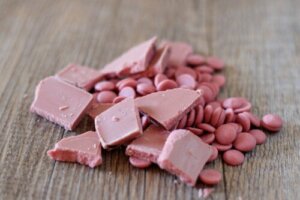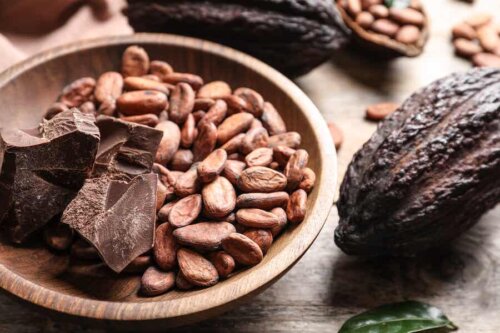What's Pink Chocolate and Where Does It Come from?


Written and verified by the nutritionist Saúl Sánchez Arias
Pink chocolate is a new product marketed by an independent brand. The reddish color is its main characteristic. However, don’t be fooled by its appearance, since it’s actually additive-free. Manufacturers obtain it from special cocoa beans.
You’ve never heard of it?
Well, continue reading, as we’re about to tell you everything you need to know about it. For one, it has many health properties!
What’s pink chocolate?
Also known as ruby chocolate, this treat is made from ruby-colored cocoa beans that some people grow in Ecuador and Brazil. There are also some plantations in the Ivory Coast.
Note that these beans don’t have a bitter taste, as is the case with most cacao. In addition, it’s all-natural and doesn’t contain colorants or sweeteners.
Even the amount of dairy products used in its production is low. However, it isn’t that big in the market yet, as it’s yet to pass a series of things related to quality control.
Check out this Cocoa Dressing to Flavor your Salads
How does it taste?
Commercial chocolate is usually sweet but pure cocoa is bitter. However, pink chocolate has a more neutral and distinctive taste. It’s kind of bittersweet so there’s, thus reducing the need to blend it with sugar.

How is it different from other chocolates?
This type of chocolate differs from other commercial ones in its lower sugar content. Thus, the cocoa concentration is higher.
Note that this substance is great for cardiovascular health. At least according to a study published in the journal Phytotherapy Research. This is why it can help balance blood pressure and this is usually related to a lower risk of heart attacks.
Also, the antioxidant effect of cocoa can help neutralize the production of free radicals in body tissues. According to research published in the journal Critical Reviews in Eukaryotic Gene Expression, this property reduces the incidence of developing complex and chronic conditions.
As we said above, pink chocolate contains less sugar than its traditional counterparts. Furthermore, this ingredient provenly increases the risk of developing metabolic problems. This is why reducing its consumption is appropriate and beneficial.
Check out this Recipe for a Chocolate-Persimmon Custard Pie
How to use pink chocolate
At the moment, it isn’t possible to buy ruby chocolate in most markets, as it’s pending acceptance by food safety agencies. However, some people usually consume it in tablet form but one can also melt it to make desserts.
For instance, you can include it in cake recipes to obtain a reddish, more appealing color — especially for children.
Is this a new variety of cacao?
Indeed, one may think of pink chocolate as a new variety. This is because it comes from a different type of cacao bean and its production process allows decreasing the amount of sugar.
This is why it might be healthier than the traditional sweetened varieties. In any case, we won’t be able to buy it until food agencies confirm its safety.

Pink chocolate: An innovation
You might find pink chocolate strange when you come across it in a grocery store. However, you now know it’s real cacao despite its surprising color. It’ll likely to compete with traditional varieties as soon as it hits the market.
This variety of cacao is as versatile as its counterparts. You can find it in tablets and add it to various dessert recipes to obtain a lovely pinkish tone.
As we mentioned above, this additive-free product will probably be on the market in a short time. In any case, try to always select versions with the least amount of added sugars.
Despite having a less bitter taste than traditional cocoa, the industry might begin to add too much sugar to gain better consumer acceptance. This is why it’s important to always read the labels!
All cited sources were thoroughly reviewed by our team to ensure their quality, reliability, currency, and validity. The bibliography of this article was considered reliable and of academic or scientific accuracy.
- Barry Callebaut. (s. f.). How ruby chocolate is made. Consultado el 26 de junio de 2023. https://www.barry-callebaut.com/fr-CH/manufacturers/how-ruby-chocolate-is-made
- Barry Callebaut. (s. f.). Ruby chocolate. A true gift from nature. Consultado el 26 de junio de 2023. https://www.barry-callebaut.com/en/ruby-chocolate-true-gift-nature
- Barry Callebaut. (s. f.). Products. Consultado el 26 de junio de 2023. https://www.barry-callebaut.com/fr-CH/manufacturers/product-filter?topic_groups%5B0%5D=8&topics%5B0%5D=16&one_per_product_base=true
- Food and Drug Administration. (2021, 3 de septiembre). Ruby Chocolate Deviating From Identity Standard; Temporary Permit for Market Testing. Federal Register. https://www.federalregister.gov/documents/2021/09/03/2021-19096/ruby-chocolate-deviating-from-identity-standard-temporary-permit-for-market-testing
- Nie, F., Liu, L., Cui, J., Zhao, Y., Zhang, D., Zhou, D., Wu, J., Li, B., Wang, T., Li, M., & Yan, M. (2023). Oligomeric Proanthocyanidins: An Updated Review of Their Natural Sources, Synthesis, and Potentials. Antioxidants (Basel, Switzerland), 12(5), 1004. https://www.ncbi.nlm.nih.gov/pmc/articles/PMC10215713/
- Tuenter, E., Sakavitsi, M. E., Rivera-Mondragón, A., Hermans, N., Foubert, K., Halabalaki, M., & Pieters, L. (2021). Ruby chocolate: A study of its phytochemical composition and quantitative comparison with dark, milk and white chocolate. Food Chemistry, 343, 128446. https://pubmed.ncbi.nlm.nih.gov/33160766/
This text is provided for informational purposes only and does not replace consultation with a professional. If in doubt, consult your specialist.








